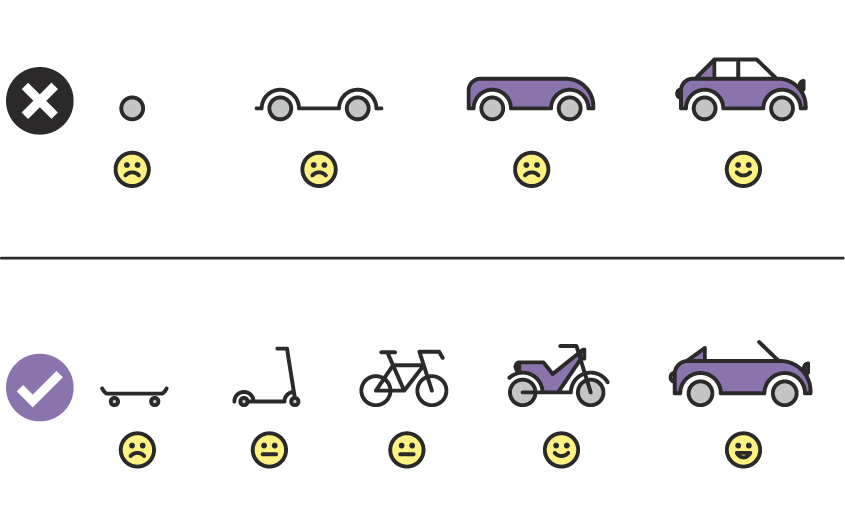Minimum Viable Product (MVP)
A Minimum Viable Product (MVP) is a version of a product with just enough features to satisfy early adopters and provide feedback for future development. The goal is to test the core idea with minimal resources before investing heavily.
Key Aspects of an MVP:
- Core Functionality Only – It includes only the must-have features that solve a problem.
- Fast to Market – It helps validate an idea quickly and cost-effectively.
- User Feedback Driven – Early users provide insights for iteration and improvement.
- Reduces Risk – It prevents wasting resources on unwanted features.
Why Use an MVP?
- To test a business hypothesis before full-scale development.
- To attract investors with a working prototype.
- To minimize time and cost while refining the product.
DOs and DONTs
| ✅ DO | ❌ DON'T |
|---|---|
| Focus on Core Value Proposition – Ensure the MVP delivers the primary benefit that solves the core problem for users. | Don’t Overcomplicate Features – Avoid feature bloat; an MVP should do one thing well rather than trying to be everything to everyone. |
| Define Clear Success Metrics – Establish measurable goals to determine if the MVP is viable (e.g., user engagement, retention, conversion rates). | Don’t Sacrifice User Experience – Even if minimal, the MVP should be intuitive, functional, and not frustrating to use. |
| Prioritise Speed and Learning – Build fast, iterate based on feedback, and avoid over-engineering at this stage. | Don’t Ignore Market Research – Building without validating the problem and market demand leads to wasted effort. |
| Test with Real Users – Release to a controlled group, gather qualitative and quantitative insights, and refine based on actual usage. | Don’t Build for Scale Too Early – Over-engineering for hypothetical future scenarios slows development and adds unnecessary complexity. |
| Keep It Scalable (Within Reason) – While not production-grade, the architecture should allow for iterative improvements without major rework. | Don’t Ignore Monetisation Strategy – Even if not charging immediately, there should be a clear path to revenue validation. |
| Leverage Existing Tools and Services – Avoid reinventing the wheel; use third-party services, no-code/low-code solutions, and APIs to accelerate development. | Don’t Treat MVP as a Prototype – It’s a functional product, not just a concept demo, and should be tested accordingly. |
| Stay Flexible – Be prepared to pivot based on insights rather than sticking rigidly to initial assumptions. | Don’t Rely Solely on Internal Opinions – Real user feedback is far more valuable than assumptions made within the team. |
| Ensure Basic Security and Compliance – Even at the MVP stage, user data protection and relevant legal requirements (e.g., GDPR, HIPAA) must be addressed. | Don’t Launch Without a Clear Next Step – An MVP is just the beginning; have a roadmap for what happens based on different possible outcomes. |
| Create a Feedback Loop – Implement mechanisms for continuous user feedback, such as surveys, analytics, and direct interviews. | Don’t Skip Documentation – Even in early-stage development, minimal documentation helps onboard new developers and maintain clarity. |
| Communicate the Vision Clearly – While the MVP is minimal, stakeholders (investors, early users, internal teams) should understand the long-term vision. | Don’t Be Afraid to Kill It – If the MVP fails to show promise despite iterations, be willing to pivot or abandon the idea instead of sinking more time and resources. |

Examples of MVPs:
Airbnb – Testing Market Demand with a Simple Website
MVP Approach: The founders built a simple website to rent out their own apartment with air mattresses and breakfast. They used this to validate if people would actually pay to stay in a stranger’s home. Outcome: Strong demand led to further iterations, investor interest, and ultimately a global marketplace for short-term rentals.
Zappos – Manual Order Fulfillment Before Scaling
MVP Approach: Instead of stocking shoes, the founder took pictures from local stores and posted them online. When someone placed an order, he would go to the store, buy the shoes, and ship them himself. Outcome: Validated demand for an online shoe retailer, leading to an acquisition by Amazon for $1.2 billion.
Uber – Testing Demand with a Simple App
MVP Approach: The first version of Uber (UberCab) was a basic app that allowed users in San Francisco to request a black car service. No dynamic pricing, no UberX—just a simple way to book a ride. Outcome: Demand skyrocketed, leading to iterations like UberX and global expansion.
LinkedIn – Basic Networking Profiles
MVP Approach: The first version of LinkedIn was a simple resume-style profile with a way to connect with colleagues. No news feed, job postings, or premium features. Outcome: It gained traction as professionals found value in networking, leading to its eventual acquisition by Microsoft for $26 billion.
Spotify – Desktop-Only Streaming Prototype
MVP Approach: Instead of building a full-fledged service, Spotify launched a desktop-only MVP in Sweden with a limited catalog. The goal was to test if users would adopt streaming over downloads. Outcome: The positive response led to licensing deals and global expansion.